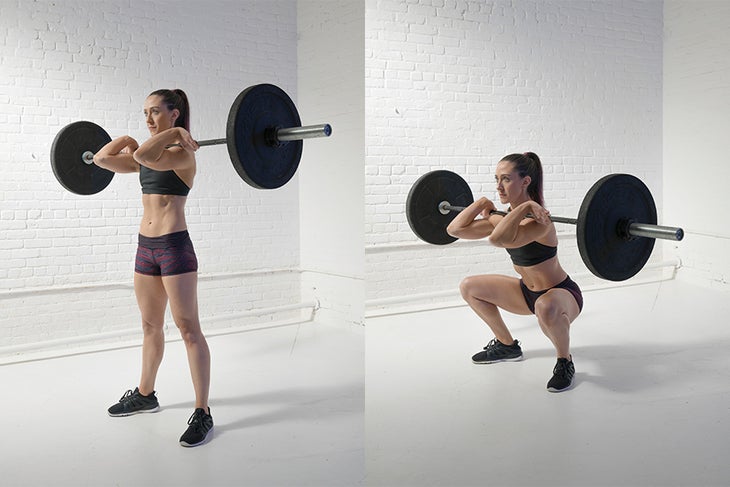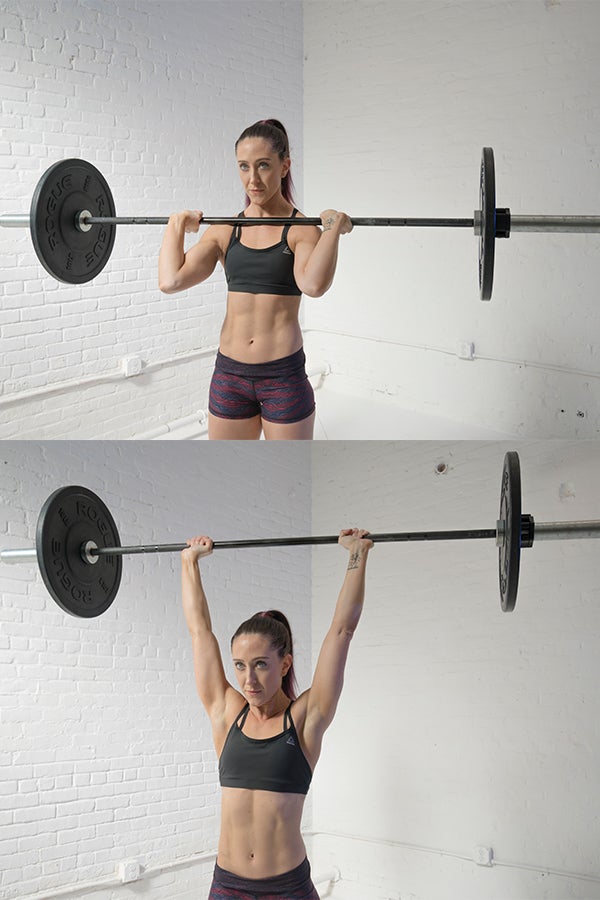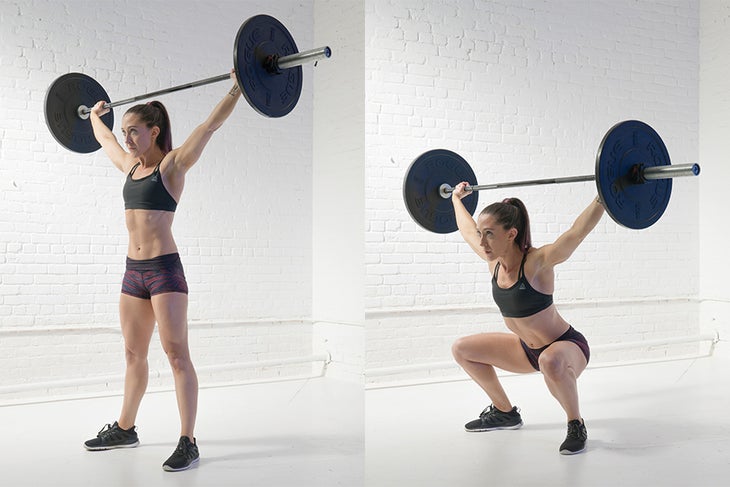
The Lean Muscle Training Program
You’ve heard it before — there are no shortcuts when it comes to fitness. But what if this were only halfway true? What if there was a faster and arguably better way to change your body and lean out, involving fewer sets and reps and less time spent in the gym? How about a shortcut you can use starting right now without regret or a lick of guilt?
Read on to find out about this magical training unicorn.
Reps on Reps
Though many people assume that lifting lighter weights for 15 to 25 or more reps somehow creates a leaner muscle as a result, the body doesn’t work like that.
“Super-long sets are great for muscular endurance,” explains Heather Farmer, an Olympic weightlifting national competitor and fitness coach in New York City. “But using heavy weights builds up your muscle tissue, giving you shape and the lean, strong look you’re after. That means working as low as two- to three-rep sets and lifting 80 to 90 percent of your one-rep max on your final sets of your major exercises.”
Lower reps by nature allow you to handle heavier loads — and that translates to exactly the type of gains the typical Oxygen reader wants. “If you’re not being challenged and moving the maximum load possible, your overall strength ceiling will be much lower,” Farmer says, adding that lifting heavy will not make you look like those swole dudes in powerlifting competitions. “Those guys get their thick, beefy bodies because of diet: They’re eating a ton of calories and storing them as body fat. If you want a lean physique, you want to build some muscle mass, and the most efficient way to do that is to push the muscle a little beyond its strength limits on a consistent basis.”
Lifting for Lean Muscle
This plan, crafted by Farmer, revolves around the key strength exercises that prompt muscle development: the front squat, the strict overhead press, the deadlift, the snatch-grip push press and the overhead squat. Combined with a variety of ancillary moves, this plan will improve strength and performance and will get you that lean, strong look you’re after.
Each workout begins with some unique warm-up moves to get your blood pumping and your mind engaged. Then you get into your big lift for the day — the one that will help build that coveted muscle tissue and boost strength. “You want to push yourself while maintaining excellent form,” Farmer says. “From week to week, strive to bump up the total amount of weight you can handle so that your one-rep max is steadily going up.”
Because lifting heavy is a new stimulus for those who have been using a higher rep schematic, you’ll need more rest to recover between sets — up to three minutes, according to Farmer. This allows your muscles and central nervous system to regroup before you hit it again with the next set.
Each workout finishes with a four-exercise circuit, which should be done briskly with minimal rest. “The idea is to handle the highest weight possible without losing form for conditioning,” Farmer says. “These circuits require coordination of the major muscle groups and give necessary attention to some more isolated, smaller muscle groups used for stabilization and overall joint health.”
For programming, Farmer recommends adding this schedule into a periodized plan. “For example, you can do three months of a lower-rep strength program (like this one), one to three months of a moderate-weight/moderate-rep program, then one to two months of higher endurance-style reps,” she says. “That will keep your body off-balance so it never has a chance to settle into a rut.”
Maxing Out
Don’t know your one-rep max? Not to worry: The “% 1RM column in this plan is meant to be a guideline. “The weight you choose can also be decided by perceived effort and doesn’t have to be an exact measurement,” Farmer says. “Some exercises may not have a clear one-rep max, and it’s not necessary to determine such a number to benefit from the exercise.”
The Lean Muscle Training Plan
Do these four workouts over the course of a week, leaving at least one or two rest days in between. For each exercise, choose a weight that is challenging enough that you’re near momentary muscle failure by the last listed rep.
Day 1: Barbell Front Squat

Hold a barbell across your upper chest and clavicle in the front rack position: elbows lifted high underneath, fingertips on the bar outside your shoulders. Keep your chest up, back flat and eyes forward as you assume a shoulder-width stance with your legs turned out slightly from your hips. Initiate the movement via the hips as you bend your knees to lower yourself as if sitting in a chair, descending until your thighs are parallel or just below with the floor. Drive through your heels and shift your hips forward to return to standing.
Tip: “Think ‘elbows up’ when driving out of the bottom of the front squat,” Farmer says. “If you drive up hips first, you’re likely to tilt forward, risking a missed lift or even a back strain.”
Barbell Front Squat Workout
| Exercise | Sets | Reps |
| Warm-Up Moves
Inchworm Lateral Squat Kettlebell Swing -superset with- Burpee |
–
2 2 2 2 |
–
6 6 (each side) 15 15 |
| Main Exercise
Barbell Front Squat |
Sets
1 1 2 2 1 |
% 1RM
50 60 75 85 90 |
| Circuit
Lateral Goblet Squat Dual-Arm Bent-Over Row Dumbbell Lunge Jump Squat |
–
3 3 3 3 |
–
8 (each side) 12 8 (each side) 12 |
Day 2: Barbell Strict Press

Hold the barbell across your shoulders and clavicle in the front rack position, but with your elbows slightly lower to allow you to get your hands completely around the bar outside your shoulders. Assume a shoulder-width stance with your pelvis neutral and core tight. Keep your chest high as you press the bar straight up overhead, using only the strength of your muscles, not momentum. Carefully lower the bar back down and allow it to come to a complete stop before beginning the next rep.
Tip: “Squeeze your glutes and brace your core to ensure stable hips and spine during the rep,” Farmer says. “Avoid overarching or disengaging your core.”
Barbell Strict Press Workout
| Exercise | Sets | Reps |
| Warm-Up Moves
Seated Cable Row Single-Arm Kettlebell Press Reverse Pec-Deck Flye |
–
2 2 2 |
–
15 15 (each arm) 15 |
| Main Exercise
Barbell Strict Press |
Sets/Reps
2/6 2/4 1/3 3/2 |
% 1RM
60 70 80 85-90 |
| Circuit
Dumbbell Curl and Press Dumbbell Push Press Dumbbell Renegade Row With Push-Up Dumbbell Triceps Extension |
–
4 4 4 4 |
–
12, 12, 8, 8 12, 12, 8, 8 12, 12, 8, 8 12, 12, 8, 8 (each arm) |
Day 3: Barbell Deadlift

Stand with your toes underneath a loaded barbell in a shoulder-width stance, close enough that your shins touch. Press your hips back and bend your knees to lower yourself down just enough to grasp the bar with a shoulder-width, alternating or overhand grip. Your back should be flat, aligned from neck to tailbone, with your weight in your heels. Keep your arms straight as you drag the bar straight up along your shins and thighs, extending your knees and hips at the same rate until you are standing. Squeeze your glutes and press your hips forward slightly at the top, then reverse the move back to the floor.
Tip: “Lock your back into place, and think of pressing your body away from the floor by driving your feet flat into the ground rather than lifting the bar up and away from it,” Farmer says.
Barbell Deadlift Workout
| Exercise | Sets | Reps/Time |
| Warm-Up Moves
Couch Stretch Alternating Kettlebell Bench Press in Glute Bridge Goblet Squat |
–
2 3 3 |
–
30-60 seconds (each leg) 10 (each arm) 15 |
| Main Exercise
Barbell Deadlift |
Sets/Reps
1/5 1/5 2/3 3/2 |
% 1RM
50 65 75 85 |
| Circuit
Dumbbell Thruster Bulgarian Split Squat Farmer’s Carry Dumbbell Romanian Deadlift |
–
4 4 4 4 |
–
10 10 (each side) 40 (total steps) 10 |
Day 4: Snatch-Grip Push Press

Position a barbell across your upper back and traps, and hold the bar in a snatch grip. (See “Finding Your Snatch Grip” below.) Bend your knees slightly to load up — keeping your feet in contact with the floor as your hips shift back — then drive forcefully upward, using your legs to generate momentum as you extend your arms to press the bar overhead, completing the lift with locked elbows and straight legs. Lower the bar carefully back down behind your neck, absorbing any impact with your knees. Reset, then repeat.
Tip: Drive through your heels — not your toes — to help push the weight upward. Coming up onto your toes could shift your body — and the barbell — forward, throwing you off-balance.
Overhead Squat

Stand with your feet shoulder-width apart, legs turned out slightly from the hips, and either snatch the bar from the ground or take it off a rack with your hands in a snatch grip (see previous page) and press it directly overhead. Actively press up against the bar as if you were pushing against the ceiling as you kick your hips back and bend your knees, squatting down slowly to help maintain balance. Go as deep as you can, ideally to a point at which your thighs come at or below parallel to the floor while maintaining your natural lower-back arch. Drive up forcefully from the bottom to full extension.
Tip: “If you have trouble going low, pause for three to five seconds at the point where the lift begins to feel unstable,” Farmer suggests. “Often when people hit their depth limit, they shoot right up, but the body never has time to adapt to the lowermost positions this way.”
Snatch-Grip Push Press + Overhead Squat Workout
| Exercise | Sets | Reps |
| Warm-Up Moves
Kettlebell Swing Lateral Goblet Squat |
–
2 2 |
–
10 10 (each leg) |
| Main Exercises
Snatch-Grip Push Press – – Overhead Squat – – |
Sets/Reps
2/5 3/3 2/2 2/5 3/2 2/2 |
% 1RM
60-65 70-75 80-90 60-65 70-75 80-90 |
| Circuit
One-Arm Landmine Press Pull-Up (or Lat Pulldown) Burpee One-Arm Landmine Row |
–
3 3 3 3 |
–
15 (each arm) 10 10 10 (each arm) |
Rack It
If you’re planning on lifting heavy — even if you have a spotter — and going for your one-rep max, it’s a good idea to use a rack. This allows you to load a bar with a heavier weight than you would be able to lift if you had to pull the bar off the floor and into position. Racks have movable pegs to hold the barbell, and some also have safety bars that can be positioned to stop the barbell and help prevent injury.
When approaching the bar in a rack, center yourself, then bend your knees and hips to get underneath the bar, positioning your hands appropriately and keeping your back straight. Then simply stand up and lift the bar off the pegs to take the load onto your person. Take a small step backward away from the rack so you don’t hit the rack when doing the exercise, position your feet properly, then begin your reps. When replacing the bar, step forward between the rack uprights and make sure both ends of the bar are positioned above the pegs before placing it down and backing out.
Where to Set the Pins
Front squat: At or just below chest height
Strict press: Just below shoulder level
Snatch-grip push press: At or just below shoulder height
Overhead squat: Just below shoulder height
We independently source all of the products that we feature on oxygenmag.com. If you buy from the links on our site, we may receive an affiliate commission, which in turn supports our work.
Published at Wed, 16 Mar 2022 04:09:50 -0700






